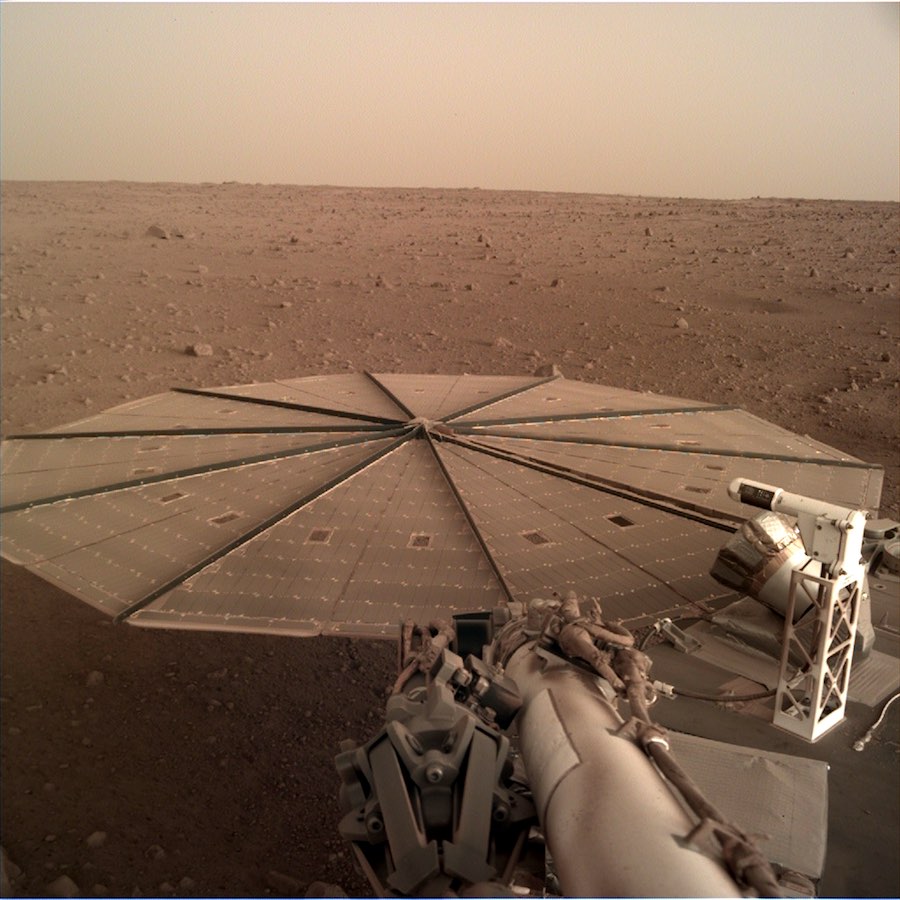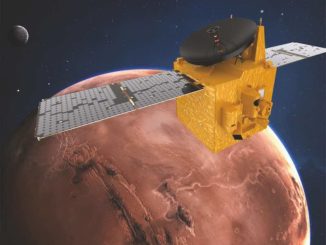
In a bit of interplanetary troubleshooting, the robot arm on NASA’s InSight Mars lander has lifted a support structure to reveal an underground thermal probe that got stuck soon after it started hammering into the Red Planet’s surface earlier this year.
Operating under long-distance commands from Earth nearly 240 million miles (385 million kilometers) away, InSight’s robotic arm completed the three-step procedure to raise the support apparatus and relocate it to a new location about 8 inches (20 centimeters) closer to the stationary lander.
The relocation revealed the mole from the mission’s German-built Heat Flow and Physical Properties Package, or HP3 instrument, which has been unable to dig into Mars since Feb. 28. The device stalled within minutes after beginning to burrow to a planned depth of 16 feet (5 feet) beneath the Martian surface, deeper than any probe has dug into the Martian crust.
Engineers decided to halt the digging to assess the mole’s condition, and develop a strategy for freeing the device.
The metallic spike only made it about a foot (30 centimeters) into the soil, and the rear of the 1.3-foot (40-centimeter) mole is still sticking out of the hole it started digging in February.
“We’ve completed the first step in our plan to save the mole” said Troy Hudson of a scientist and engineer with the InSight mission at NASA’s Jet Propulsion Laboratory in Pasadena, California. “We’re not done yet. But for the moment, the entire team is elated because we’re that much closer to getting the mole moving again.”
Can you dig it? We’re troubleshooting on Mars from almost 240 million miles away.
Over the weekend, @NASAInSight used its robotic arm to move the support structure for “the mole” in an effort to get the heat-sensing probe burrowing again. https://t.co/XYNbIvrGQe pic.twitter.com/vVppSerXXJ
— NASA JPL (@NASAJPL) July 1, 2019
A series of images taken by InSight’s cameras showed a pit around the circumference of the mole, evidence that supports the leading hypothesis for the reason the instrument got stuck in February.
“I along with others from the team were a bit shocked when we saw how large the pit actually is,” wrote Tilman Spohn, the HP3 instrument lead at DLR, the German space agency. “Its diameter is about two times the diameter of the mole.”
German engineers believe the Martian soil at InSight’s landing site is not offering enough friction, or resistance, to prevent the mole from recoiling with each hammer stroke.
“The images coming back from Mars confirm what we’ve seen in our testing here on Earth,” Mattias Grott, HP3 project scientist at DLR. “Our calculations were correct: This cohesive soil is compacting into walls as the mole hammers.”

The operation to lift the support structure was risky. The robotic arm transferred the HP3 instrument from InSight’s payload deck onto the Martian surface after the mission’s landing last year, but mission planners never intended the arm to pick up part of the instrument once it was on the ground.
The robotic arm grappled the support structure in mid-June and lifted it in three carefully-choreographed steps to ensure the the arm did not pull the mole out of the ground. If the mole comes out of its hole, officials say the instrument can’t be saved.
A ribbon-like tether trails behind the mole, through the support structure, and back to the InSight lander. The umbilical routes power to the instrument, and allows data from temperature sensors on the mole and tether to flow back to the lander for transmission back to Earth.
Engineers also opted for a deliberate approach to lifting the support structure to minimize the risk of damaging the tether.
InSight’s ground team will collect more images of the mole in the coming days before pressing ahead with the next step in saving the mole. Engineers will most likely command the lander’s robotic arm to press on the soil around the mole to fill in the pit, providing the necessary friction for the instrument to resume digging.
There is still a chance that the mole hit a rock.
“While the mole is designed to push small rocks out of the way or deflect around them, larger ones will prevent the spike’s forward progress,” NASA said in a statement.
Mission planners selected InSight’s landing site on a broad flat plain near the Martian equator to minimize the chances of encountering a rock obstruction.
“The robotic arm’s grapple isn’t designed to lift the mole once it’s out of its support structure, so it won’t be able to relocate the mole if a rock is blocking it,” NASA said.

The HP3 instrument is designed to gather data on underground temperatures at varying depths, giving scientists a clearer understanding of the amount of heat escaping the Martian interior. HP3 is one of two geophysics instruments InSight carried to Mars, along with a French-built seismometer, which is working as expected and has already detected multiple marsquakes.
The seismometer recorded its first marsquake April 6, and the instrument registered its largest seismic signal to date May 22, a tremor scientists estimate at magnitude 3.0.
A third major science investigation on the InSight mission is the Rotation and Interior Structure Experiment, or RISE, which uses radio signals passed between the lander and Earth to measure the wobble of Mars’s rotation, giving scientists an idea of the Red Planet’s core size and density.
InSight is the first mission dedicated to studying the interior of Mars, and scientists say the $1 billion project will yield data to help them understand how rocky plants, including Earth, formed and evolved in the ancient solar system more than 4 billion years ago.
Email the author.
Follow Stephen Clark on Twitter: @StephenClark1.



